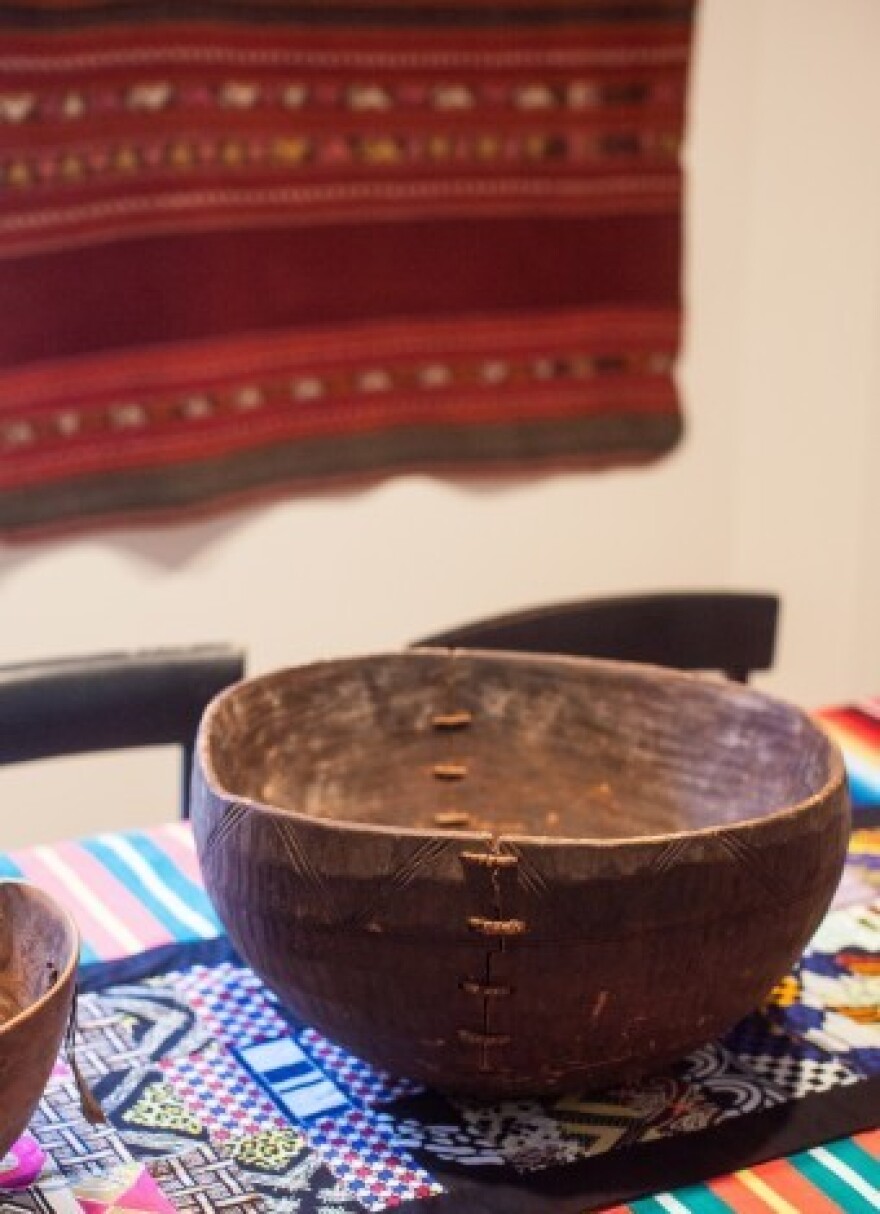This article originally appeared in the St. Louis Beacon. - Art and science often seem to exist on opposite ends of a spectrum bookended by the likes of Georgia O’Keeffe and George Washington Carver. But for Pulitzer Foundation for the Arts director Kristina Van Dyke, the two worlds collide in an art collection inspired by archeology, geology and even radiology.
Van Dyke’s Lafayette Square carriage home beckons visitors down a stone pathway to a comfy marriage of natural oddities and African creations. Much of the display inside the fewer-than-1,000-foot cottage involves pieces Van Dyke collected during a year of doctoral field work in Mali.
But in recent years, Van Dyke has become fascinated by fossils and the history of the world before humans made art -- before humans, period. It’s a focus that takes the pressure off everyday living, knowing our existence is just a blip in time.
“There’s something really humbling about that, but also very exciting because it’s liberating -- like you can just relax a little bit,” Van Dyke said.
Mementos and memories
Growing up in Lake Geneva, Wis., Van Dyke first delighted in the details of history-rich items through her mother’s work.
“She was an antiques dealer, and that required me to go to a lot of antique shops and flea markets, which helped develop my eye,” Van Dyke said.
But it was the Mali experience through her Harvard PhD program 10 years ago that took Van Dyke from appreciation to acquisition. In her living room window lives a Malian marionette -- purchased from an antique shop there -- stripped of her dress, shoes, ability to dance and likely basket. It is in this state that one can fully appreciate her artistry.
“I think she’s a great carving,” Van Dyke said. “She’s really great in profile; the sculptor had a real sense of control here.”

The marionette and nearby Fuloni blanket and Bamana mudcloth pillows make up what Van Dyke calls “my first round of African art.”
“It’s really the first time I felt connected, like I really wanted to own or live with some things,” Van Dyke said. The living room includes the marionette in the window, Fulani blanket and Bamana mudcloth pillows, all from Mali.
Soon, Van Dyke began a regular habit of shipping home her Malian finds including numerous cooking utensils and wooden bowls with burned-in designs. When she has guests, the bowls conjure up memories of Malian meals, in which women and men were segregated with each group of up to 40 people eating out of one bowl.
“The bowl would be heaped with rice, sauce and meat, then set down in the middle of a circle,” Van Dyke recalled. “You eat with your right hand, using your hand to get a ball of rice, and dip it into the sauce. It’s very challenging.”
A little soap and water is all that’s needed to clean the bowls and “the more worn they are, the more beautiful they become,” Van Dyke said. Small metal pieces long ago affixed to any splits in the wood returned the bowls to usefulness and testify to the resourcefulness of the African people, Van Dyke said.
“Africans don’t waste anything,” she said. “And I love the whimsy of the repair. It actually adds something to the visual quality of the bowl.”
New and old
Van Dyke is equally effusive about a pair of newer African-made baskets. Woven by Ghanian women, the vibrant containers were purchased at a location much closer to home: Whole Foods market in Brentwood.
“This one was $32. It’s so beautiful and has great colors. I want to buy one every time I go there,” she said.
Something else newer -- a framed collection of CT scans of a terra cotta figure -- is the focal point in Van Dyke’s upstairs office.

Prior to coming to St. Louis, Van Dyke spent six years as a curator for the Menil Collection in Houston. There, her curiosity about several pieces from Mali’s Inland Niger Delta led her to a conservation department radiologist, seeking the secrets within: Was there a pattern of similar assembly among diverse pieces? Was that one solid? Was this one a fake?
Fakes are often revealed to have a newer body but with perhaps a foot or the back of a leg made of older, ground-up material. When those commonly tested parts are examined for age, it can be wrongly assumed that the entire piece originated from a much earlier period. The CAT scan confirmed that the pictured figure, and all the Menil pieces, were genuine.
“If his head didn’t belong to this body, the distribution of all these little white particles would be different, and immediately you would know,” Van Dyke said.
‘My secret’s out’
Video by Jarred Gastreich | for the Beacon
While at The Menil, Van Dyke fell in love 600 miles away in West Texas: with rocks. Visiting sculptor Donald Judd’s Marfa Foundation, Van Dyke had an epiphany as she hiked through the area’s “unforgiving, epic landscape.” Rocks and fossils gleaming in the sun, some 200 million years old, called to her, bidding her to pick them up.
Now they’re an important part of her domestic collection. She’s especially fond of a fossil in which an entire flower has been preserved, a rare find.
“Now I’m waxing poetic about rocks. I guess my secret’s out,” Van Dyke laughed. “But my colleagues are definitely already on to it. There’s some seepage in my office.”
Another display of smooth rocks, worn by water and time, hails from the Atlantic coast. Shown neatly, in rows, according to size, they demonstrate the power of a collection.
“The more you have, the more you can see the different qualities,” Van Dyke said.

A dining-room wall display of branches, tiny pinecones, roots and antler-like sticks -- pulls from the newest chapter in her life. Bit by bit, various objects from Missouri and Illinois hiking trails have joined a collection that pulls from adventures in Texas, New Mexico, New York and Wyoming.
Her arrangements are "deeply diverse," according to Lisa Melandri, director of the St. Louis’ Contemporary Art Museum. Van Dyke’s collection is the manifestation of her intelligence, Melandri said.
“What I love most about her kind of art and her collecting is that I think she is a truly and deeply curious mind,” Melandri said. “You get this whole flavor of the universe from the objects in her space.”
But in Houston, much of this universal flavor would have been found packed away in boxes. Van Dyke preferred living in a more minimalist environment then, according to Susan Sutton, with whom she worked at The Menil.
“She would have things out that she brought back from Africa but it was much more restrained,” Sutton said.
About this series
From time to time, we will take readers into the homes of people who work in visual arts or who have built art collections of note. With the first group, the reader may discover the private tastes and curiosities of those who determine public displays or choose what to offer for sale. The other articles are a chance to glimpse works no longer in the public domain. In all, those who collect will talk about their inspiration and tips for others on their own path of collecting.
For more in this series, click here.
There’s a good reason for that shift, Van Dyke explained. As curator at The Menil, a collecting institution, she was constantly interacting with objects. But The Pulitzer doesn’t house a collection. And as she becomes more entrenched in St. Louis, more and more "found" and purchased treasures find a home in her domestic space.
“I think the longer I’m here, the more I miss playing with objects,” Van Dyke said. “And I feel the need to create these visual displays.”
Kristina Van Dyke’s Collecting Tips
- Cast the net wide and live with different things. Once you discover what it is you like, you can start to become more focused.
- The more pieces you have in a particular collection of items, the better you can compare and contrast them.


